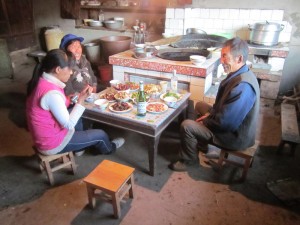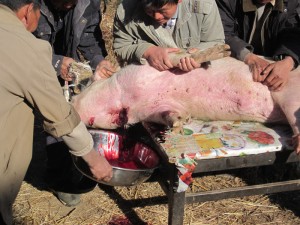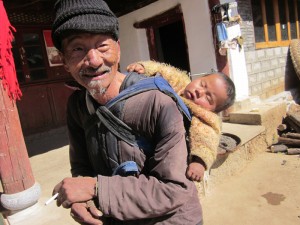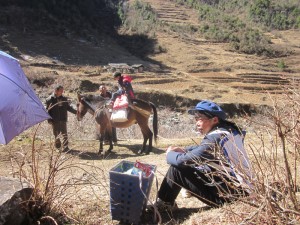Boar’s Wallow. Now that’s a poetic name! It’s the Naxi name for a small mountain village in northwestern Yunnan Province, which name loses its bucolic flavor in China Post’s Mandarin designation Xinshang Xiacun, something like “New Respect Lower Village”. Boar’s Wallow is less optimistic, but more to the point.

The Naxi are a people of Tibetan abstraction, who have inhabited these alpine meadows and valleys for a thousand years at least, once as an autonomous kingdom centered at the city of Lijiang. Only about 250,000 strong today, they still maintain their language, architecture, religion and cuisine.
Dominating the view to the southeast is the majestic Jade Dragon Snow Mountain, Lijiang’s trademark. From higher elevations around the village one glimpses the Jinsha River, a major headwater of the Yangtze.

It is in newly respectable Boar’s Wallow that I spent my Lunar New Year holiday, guest of a family whose daughter is a university English major, fluent in Chinese, but at home in the Naxi language. A rare privilege for me indeed.
The boars no longer wallow here. They were wild boars, destructive of fields and crops, and were ultimately decimated by human artifice. I suppose elimination of the pesky boars has made life easier here, but “posh” hardly describes the post-boar life-style. The toughness of life here is evident even at the time of Spring Festival feasting. It is the toughness of self-sufficiency, a concept lost to the soft-boiled civilizations at the other end of the Yangtze. It is the toughness of survival.
You need vegetables? Go to your fields — amazingly green even in early February — and pick

some. You need sugar? Extract the fructose from the corn you have ground, and boil it down to a viscous syrup. An egg? See if the hens have obliged. Meat? Go slaughter a pig. Be sure to salt and air-dry some of the meat to preserve it for another day. And don’t plan on selling the indelicate parts to the dog-food factory — eat them; expertly cooked, they’re tasty. The alpine air too cold for you? Go to the forest and fetch lots of firewood. You’ll need some to heat the double-wok stove, and some to kindle a brazier around which you can sit after dinner and chat with family and friends, all with palms extended to absorb the radiant heat. Need to relieve yourself? The outhouse is just across the cabbage patch; there’s plenty of old notebooks there.

Buildings are of unique design, yet in a layout familiar to anyone who has visited a European farm village. Three or four modular structures enclose a courtyard; these house humans and animals in rough proportion to the head-count of the extended family and their livestock. Each building is defined as a 2 x 3 grid of bays by the placement of poles and rafters, with exterior walls of mud-brick on three sides. The buildings have two storeys , with a dividing eve partway up the second storey. The six back bays, upstairs and down, may be finished as bedrooms, living rooms, kitchens, or they may be open and serve as mows or sheltered storage for dried vegetables and meats. In any case, the three front bays on the ground floor are open as a sort of veranda, where most of family life takes place. The same floor plan serves well to house domestic animals, the bays boxed in as ox stalls, pig sties, chicken coups, etc.
The pole-and-rafter structure is pinioned nailessly, and structurally independent of the

mud-brick walls, all the better to absorb the movements of earthquakes, which are frequent in the region. Roofs are dark gray tiles in alternating concave-convex rows. All together a very charming, practical and adaptable design.
I wouldn’t speculate on the fecundity of Naxi women, but to note that almost every home I visited had multiple children running around or being ported in Naxi-style backpacks. And to note further that the Chinese one-child policy is explicitly waived for members of the 56 officially recognized ethnic minority groups in China.

Gentrification a la Boar’s Wallow is evident: electric wires seem to connect every home, and a satellite TV dish is a real status symbol, oddly perched though it may be on the chicken coup. And ‘most everyone has his or her mobile phone. Electricity is used sparsely: a bare bulb in the kitchen, an electric grill, and a clothes washing machine were the only obvious equipment in my hosts’ home.
And, of course, the television set, which, following urban Han Chinese practice, seems to be on continuously, whether anyone is watching or not, and in view of which honored guests are always invited to sit. The catch is that you have to comprehend Chinese to watch; mostly the younger, Chinese-schooled folks are watching. Mercifully, in my hosts’ home — with no youth around — the TV set sat cold and isolated in the absent son’s bedroom.
What else can you do for fun in Boar’s Wallow? Get out the mahjong tiles. On these relatively

leisurely holiday afternoons countless hours were spent, by young and old alike, at the mahjong table, as countless one-yuan-notes changed hands.
Inevitably my day for departure came. Rather than retrace our ride down the valley, the suggestion was to walk up the valley, over the pass and down into a neighboring valley, whence we took a van ride the next day to Lijiang. Up and up we climbed, over stoney paths fit only for humans and horses, ever closer to the Jade Dragon. After five hours we attained the top of the pass, some 3,200 m (about 10,000 ft). My friend’s father, who knew the route and toted our lunch, — much to my surprise at least — said “good-bye”, turned and started back down the path to his home: he was just seeing me off!
A stunningly beautiful and arduous walk it was.
As I sit now in my comfortable apartment in Kunming, connected to the internet, typing on computer, munching on packaged foods, I have a sense of awe, not so much at the landscape I have seen, but at the tenacity of humankind in coping with it. For better or for worse, we have left our mark on that landscape, and survived.